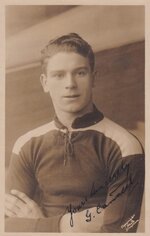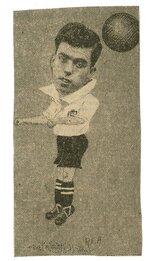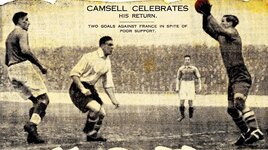As England prepare to face France for a place in the FIFA World Cup Quarter Final, football historian Dr Tosh Warwick turns back the clock to 89 years ago this week as he delves into his forthcoming biography of George Camsell to reveal the story of England’s joint record goalscorer against Les Bleus…

England’s soccer prestige was never in danger against France…From start to finish the English side held the whip hand, and won by 4-1…with a little more concentration the English score could have been larger, for while the Frenchmen were fast and at time very clever, there was that little touch of class missing from their play.
Words, no doubt, all England fans would be delighted to read come Sunday morning as they flick through the morning newspapers – or at least online news pages – looking back on an England triumph against their rivals from across the Channel. In fact, the report of English sporting supremacy comes from a clash between the two sides in 1933, a victory gained with Middlesbrough’s George Camsell at the heart of the England attack and en route to a personal milestone of bringing himself level with Dixie Dean as the leading England goalscorer against France.
From pit boy to international goalscoring sensation
It was not the first time that the former Durham City star had humbled the French. In fact, some four years earlier, the promising Framwellgate Moor-born forward made his international debut against Les Bleus in the Parisian commune of Colombes to complete a remarkable rise for the pit boy whose footballing talent was reputedly discovered as he played with workmates during a miners’ strike in the Durham coalfields. Having excelled in front of goal in non-league northern football, Camsell made the step up to league football with Durham City before joining Middlesbrough in 1925. It took a season for Camsell to secure a regular first team place and remarkably in his first full season – although he missed the opening four games of the campaign – he bagged a record 59 league goals in the 1926/27 season to help his side to top-flight promotion, before going on to score over 30 goals in each of the seasons prior to his international debut.
In May 1929, fresh from his 33 league goals helping his club side regain promotion to the top-flight, Camsell adapted to the challenges of international football just as he had done throughout his career – by scoring. He grabbed a brace to help the visitors to a 4-1 win on his debut, opening his international account by putting England 2-1 up in the second half after the home side had responded to fellow brace hero Edgar Kail’s opener. The amateur inside right from Dulwich Hamlet added another before Camsell scored the game’s final goal in the closing minutes to cap off an impressive first international appearance.
International wilderness
England continued their Continental Tour and Camsell continued his scoring streak. Two days after the success in France, Camsell added to his haul with four goals in a 5-1 win over Belgium. His fine international form continued later that year with a brace against Ireland in October and a hat-trick against Wales the following month. In today’s England side, 11 goals in four games from the new kid on the block (although Camsell was in his mid-twenties) would not only cement a forward’s place in the starting line-up but would be accompanied by a media frenzy and links to a big money move world’s leading clubs. Instead for Camsell, four years in the international wilderness beckoned with the selection committee instead opting to place the goalscoring responsibilities elsewhere such was the abundance of goalscoring options at the time. Unsurprisingly, Camsell’s great rival and friend Dixie Dean – the man who beat the Boro man’s 59 league goals the following season with a 60 goal haul – was amongst the replacements up front, with the Everton man netting an impressive 18 goals in 16 England appearances either side of Camsell’s bow. Journalists and supporters alike struggled to understand or explain Camsell’s absence in the ensuing years, although one reporter suggested George’s game ‘had suffered because he adopted a style that was foreign to him. He forsook the go-ahead stuff and tried to become the polished player’.
‘Camsell celebrates his return: Two goals against France in spite of poor support’
It would be December 1933 when Camsell eventually returned to the England line-up off the back of rich club form that had won acclaim from critics, including one writer who declared
In the opinion of many Camsell is the best centre-forward in the game today, and he ought to be England’s leader for the match with France on December 6…if England has a better leader than Camsell she is indeed fortunate.
Another reporter aligned the return with Camsell having ‘developed his game to an extent that none, even of his strongest admirers, ever believed possible. A goal a match, with not always the very best of support, surely proves Camsell to be one of the most dangerous centres in the country’.
The December 6 clash at Tottenham Hotspur’s White Hart Lane attracted 17,097 supporters and within 15 minutes of his return, Camsell was on the scoresheet after he ‘completely deceived one of the French backs by pretending to pass, and then with his short, quick strides went through to fire a winning shot from about 15 yards’ to fire England into the lead. The lead was soon doubled by Manchester City’s Eric Brook before Camsell added his second and England’s third just before half-time. Descriptions of the goal vary from blame on French stopper Defosse for fisting a cross-shot into the goal to The Times’ reporting an ‘extraordinary goal’ scored from the corner flag with ‘the ball swerving on to the crossbar and dropping over the line’. Birmingham’s Grosvenor added a fourth for the hosts after the break before the visitors finally got themselves on the scoresheet as RC Paris’ Émile Veinante hit home a consolation goal.
The two-goal performance brought praise in the following day’s newspapers with the former pit boy hailed as the ‘complete centre forward’ in a ‘personal triumph’ for Camsell who The Daily Mirror described as a ‘definite success on his return to the side’. Once again, despite Camsell’s brace, he once again found himself in international exile as the spot was filled by a variety of forwards including Derby County’s Jack Bowers - the top-flight’s top scorer in the previous campaign and enroute to topping the scoring charts again – and later Ted Drake, Hughie Gallacher and fellow Framwellgate Moor lad W.G. Richardson.
The Boro man would eventually return to White Hart Lane with the national side to help England defeat a Nazi Germany side in 1936 where he once again bagged a brace en route to an England total of 18 goals in 9 games – a record goals-to-games ratio for the national side and one unlikely to be broken despite the efforts of Kane and co. in Qatar on Saturday evening.
Adapted from Tosh Warwick’s biography of George Camsell, to be published next year by Heritage Unlocked. Visit www.heritageunlocked.com for more information.



England’s soccer prestige was never in danger against France…From start to finish the English side held the whip hand, and won by 4-1…with a little more concentration the English score could have been larger, for while the Frenchmen were fast and at time very clever, there was that little touch of class missing from their play.
Words, no doubt, all England fans would be delighted to read come Sunday morning as they flick through the morning newspapers – or at least online news pages – looking back on an England triumph against their rivals from across the Channel. In fact, the report of English sporting supremacy comes from a clash between the two sides in 1933, a victory gained with Middlesbrough’s George Camsell at the heart of the England attack and en route to a personal milestone of bringing himself level with Dixie Dean as the leading England goalscorer against France.
From pit boy to international goalscoring sensation
It was not the first time that the former Durham City star had humbled the French. In fact, some four years earlier, the promising Framwellgate Moor-born forward made his international debut against Les Bleus in the Parisian commune of Colombes to complete a remarkable rise for the pit boy whose footballing talent was reputedly discovered as he played with workmates during a miners’ strike in the Durham coalfields. Having excelled in front of goal in non-league northern football, Camsell made the step up to league football with Durham City before joining Middlesbrough in 1925. It took a season for Camsell to secure a regular first team place and remarkably in his first full season – although he missed the opening four games of the campaign – he bagged a record 59 league goals in the 1926/27 season to help his side to top-flight promotion, before going on to score over 30 goals in each of the seasons prior to his international debut.
In May 1929, fresh from his 33 league goals helping his club side regain promotion to the top-flight, Camsell adapted to the challenges of international football just as he had done throughout his career – by scoring. He grabbed a brace to help the visitors to a 4-1 win on his debut, opening his international account by putting England 2-1 up in the second half after the home side had responded to fellow brace hero Edgar Kail’s opener. The amateur inside right from Dulwich Hamlet added another before Camsell scored the game’s final goal in the closing minutes to cap off an impressive first international appearance.
International wilderness
England continued their Continental Tour and Camsell continued his scoring streak. Two days after the success in France, Camsell added to his haul with four goals in a 5-1 win over Belgium. His fine international form continued later that year with a brace against Ireland in October and a hat-trick against Wales the following month. In today’s England side, 11 goals in four games from the new kid on the block (although Camsell was in his mid-twenties) would not only cement a forward’s place in the starting line-up but would be accompanied by a media frenzy and links to a big money move world’s leading clubs. Instead for Camsell, four years in the international wilderness beckoned with the selection committee instead opting to place the goalscoring responsibilities elsewhere such was the abundance of goalscoring options at the time. Unsurprisingly, Camsell’s great rival and friend Dixie Dean – the man who beat the Boro man’s 59 league goals the following season with a 60 goal haul – was amongst the replacements up front, with the Everton man netting an impressive 18 goals in 16 England appearances either side of Camsell’s bow. Journalists and supporters alike struggled to understand or explain Camsell’s absence in the ensuing years, although one reporter suggested George’s game ‘had suffered because he adopted a style that was foreign to him. He forsook the go-ahead stuff and tried to become the polished player’.
‘Camsell celebrates his return: Two goals against France in spite of poor support’
It would be December 1933 when Camsell eventually returned to the England line-up off the back of rich club form that had won acclaim from critics, including one writer who declared
In the opinion of many Camsell is the best centre-forward in the game today, and he ought to be England’s leader for the match with France on December 6…if England has a better leader than Camsell she is indeed fortunate.
Another reporter aligned the return with Camsell having ‘developed his game to an extent that none, even of his strongest admirers, ever believed possible. A goal a match, with not always the very best of support, surely proves Camsell to be one of the most dangerous centres in the country’.
The December 6 clash at Tottenham Hotspur’s White Hart Lane attracted 17,097 supporters and within 15 minutes of his return, Camsell was on the scoresheet after he ‘completely deceived one of the French backs by pretending to pass, and then with his short, quick strides went through to fire a winning shot from about 15 yards’ to fire England into the lead. The lead was soon doubled by Manchester City’s Eric Brook before Camsell added his second and England’s third just before half-time. Descriptions of the goal vary from blame on French stopper Defosse for fisting a cross-shot into the goal to The Times’ reporting an ‘extraordinary goal’ scored from the corner flag with ‘the ball swerving on to the crossbar and dropping over the line’. Birmingham’s Grosvenor added a fourth for the hosts after the break before the visitors finally got themselves on the scoresheet as RC Paris’ Émile Veinante hit home a consolation goal.
The two-goal performance brought praise in the following day’s newspapers with the former pit boy hailed as the ‘complete centre forward’ in a ‘personal triumph’ for Camsell who The Daily Mirror described as a ‘definite success on his return to the side’. Once again, despite Camsell’s brace, he once again found himself in international exile as the spot was filled by a variety of forwards including Derby County’s Jack Bowers - the top-flight’s top scorer in the previous campaign and enroute to topping the scoring charts again – and later Ted Drake, Hughie Gallacher and fellow Framwellgate Moor lad W.G. Richardson.
The Boro man would eventually return to White Hart Lane with the national side to help England defeat a Nazi Germany side in 1936 where he once again bagged a brace en route to an England total of 18 goals in 9 games – a record goals-to-games ratio for the national side and one unlikely to be broken despite the efforts of Kane and co. in Qatar on Saturday evening.
Adapted from Tosh Warwick’s biography of George Camsell, to be published next year by Heritage Unlocked. Visit www.heritageunlocked.com for more information.


